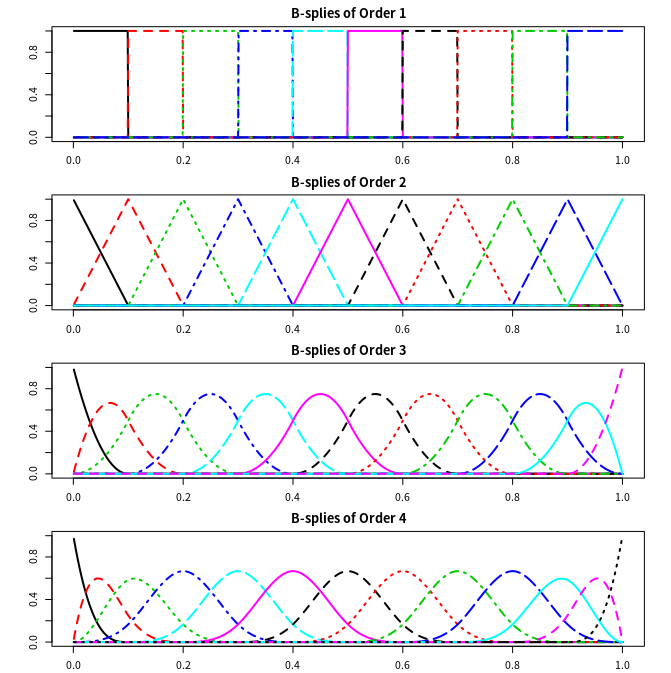B spline in R, C++ and Python¶
| 原文 | 第五章附录:B 样条的计算 |
|---|---|
| 作者 | szcf-weiya |
| 发布 | 2020-05-14 |
在 Functional Data Analysis (FDA) 中,很重要的一步便是对原始数据进行光滑化,其中经常用到 B spline,而 FDA 有个很强大的 R package fda,里面就包含 B 样条的实现方法。
Implement in R¶
create.bspline.basis(rangeval=NULL, nbasis=NULL, norder=4,
breaks=NULL, dropind=NULL, quadvals=NULL, values=NULL,
basisvalues=NULL, names="bspl")
其中
rangeval为定义域,比如0:1即表示[0, 1]breaks为结点序列,包含边界结点,即必须满足breaks[1] = rangeval[1]和breaks[end] = rangeval[2].nbasis为基函数个数,满足数量关系,
用 ESL 中的符号即为
因为 knots 编号为 $\xi_0,\xi_1,\ldots,\xi_K,\xi_{K+1}$,其中 $\xi_0$ 和 $\xi_{K+1}$ 是边界结点。
bbasis = vector("list", 4)
for (i in 1:4){
bbasis[[i]] = create.bspline.basis(0:1, nbasis = 11 + i - 2, norder = i)
# or
# bbasis[[i]] = create.bspline.basis(0:1, breaks = seq(0, 1, by = 0.1), norder = i)
}
# or directly use the plot method
par(mfrow=c(4, 1), mar=c(2.1, 4.1, 2.1, 2.1))
for (i in 1:4){
plot(bbasis[[i]], lwd = 2, cex.axis = 1.5)
title(paste("B-splines of Order", i))
}
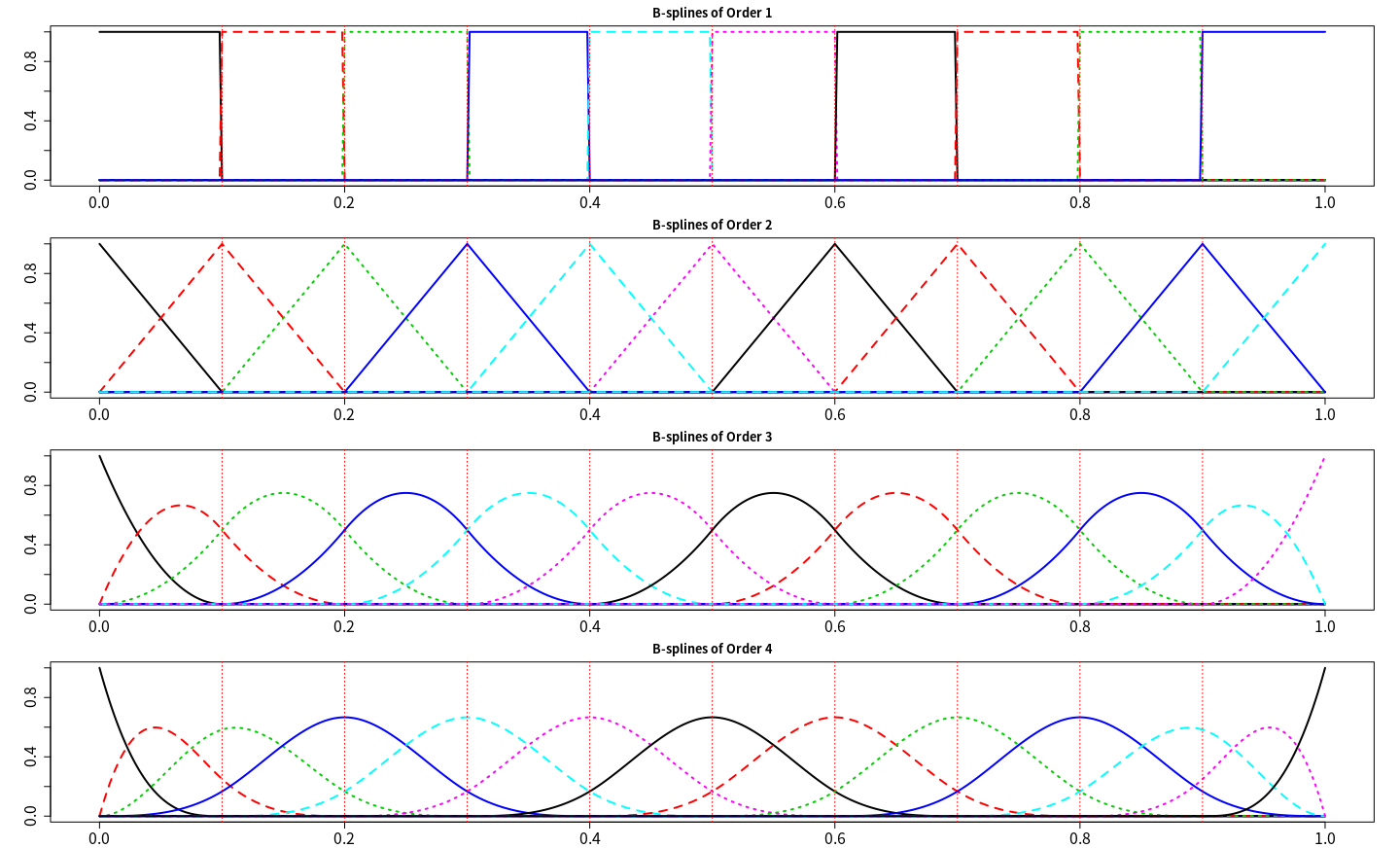
为了进一步理解样条函数,我们还可以自己对样条函数进行赋值,
# reduce space gap between multiple graphs in R
# https://stackoverflow.com/questions/15848942/how-to-reduce-space-gap-between-multiple-graphs-in-r
par(mfrow=c(4, 1), mar=c(2.1, 4.1, 2.1, 2.1))
for (i in 1:4){
bvals = eval.basis(0:1000*0.001, bbasis[[i]])
matplot(0:1000*0.001, bvals, type = "l", lty = 1, lwd = 2, cex.axis = 1.5, xlab = "", ylab = "")
abline(v=0:10*0.1, lty=2, lwd=1, col = "gray")
title(paste("B-splines of Order", i))
}
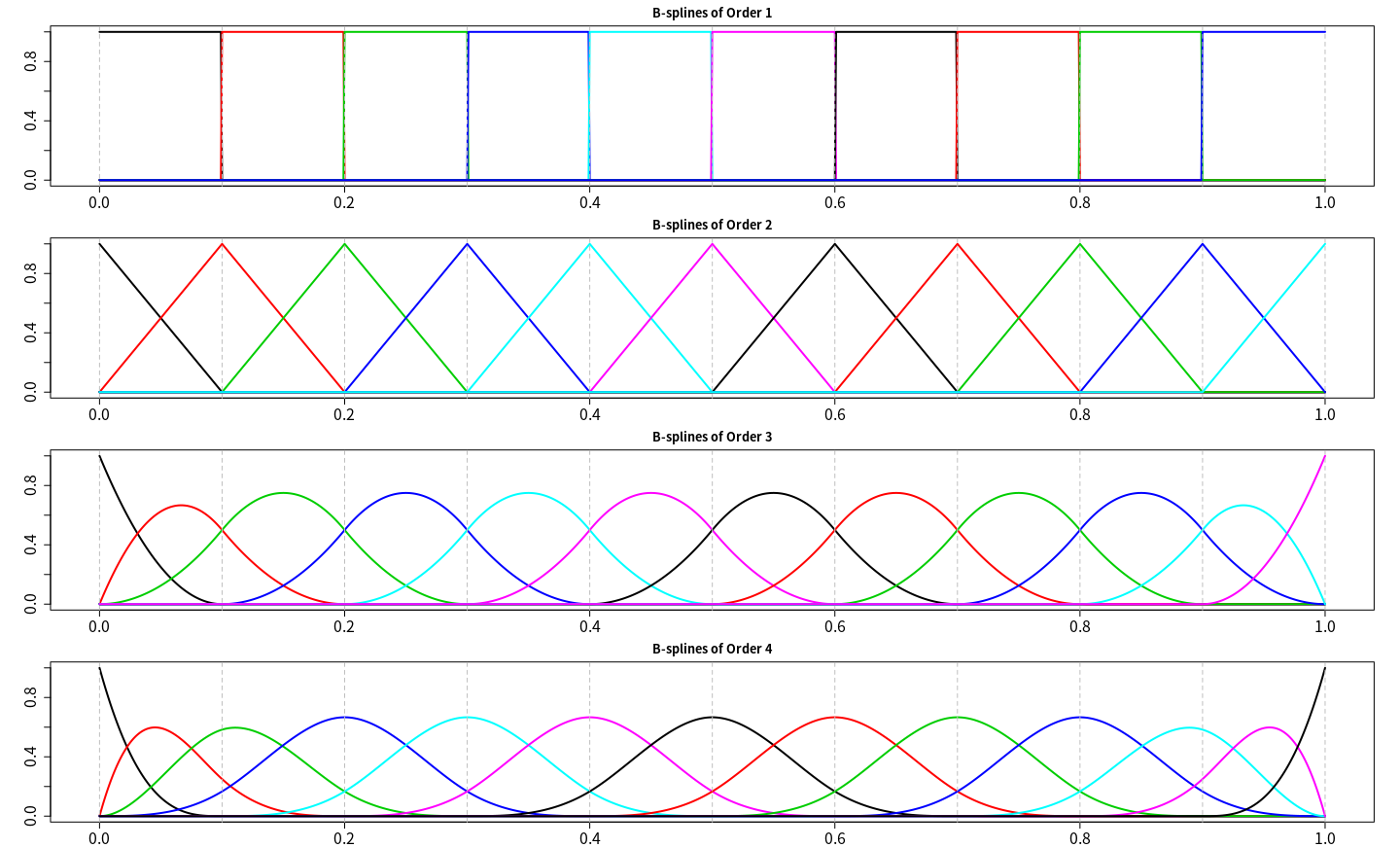
如果不指定 breaks,只给出 nbasis,则结点是在定义域内均匀取点,但是有时候实际问题中可能想要在观测值多的地方多取点,而观测值少的地方少取点,这可以通过
create.bspline.irregular(argvals,
nbasis=max(norder, round(sqrt(length(argvals)))),
norder=4,
breaks=quantile(argvals, seq(0, 1, length.out=nbasis-norder+2)),
dropind=NULL, quadvals=NULL, values=NULL,
basisvalues=NULL, names="bspl", plot.=FALSE, ...)
实现,可以看到 breaks 是通过分位数来确定,所以满足刚刚提到的这种需求。当然,如果知道 breaks,完全可以直接用 create.bspline.basis,因为 create.bspline.irregular 最终也是要调用它的。
另外,splines 包的 bs() 也会返回 B 样条基函数赋值矩阵,类似于 eval.basis(),但不同的是,bs() 中的结点为内结点,而边界结点默认为赋值区域的两端,而且其有 intercept 参数,默认为 FALSE,表示将每个基函数的常数部分提出来然后合并在一起,如果是 TRUE,则每个基函数保留各自的常数部分,列数即等于 $K+M$,但是当把常数都提出后,自由度少一,即 FALSE 情况下列数少一列。如果将其结果用于线性回归,则
lm(y ~ 0 + bs(x, intercept=TRUE))
# or
lm(y ~ bs(x, intercept=FALSE))
默认为 FALSE 时,常数项被放到 y ~ x 中的截距项中去了,而 TRUE 时已经保留了常数项,则没必要再要求截距项,否则后面估计可能出现问题,比如出现 NA。
Implement in Python¶
Python 中的 scipy 库也可以实现 B spline,具体函数为
scipy.interpolate.BSpline(t, c, k, extrapolate=True, axis=0)
其中,
k: degree,则 $M$ =k+ 1t: 长度为n+k+1的结点序列,即n+ M, 其中定义域为t[k] .. t[n],这两个也刚好是边界结点.t[0], t[1], ..., t[k-1]对应增广的结点序列 $\tau_1,\ldots, \tau_{M-1}$,而t[n+1], t[n+2], ..., t[n+k]对应 $\tau_{K+M+2},\ldots, \tau_{K+2M}$. 而且需注意到边界结点不再出现在增广结点序列中,即 $\xi_0, \xi_{K+1}$ 不会出现在t中,但一般 $\tau_{M} = \xi_0; \tau_{K+M+1} = \xi_{K+1}$, 所以t[k], t[k+1], ..., t[n]为基础结点序列(包含两个边界结点),$\xi_0,\xi_1,\ldots,\xi_K, \xi_{K+1}$,个数为n - k + 1= K + M -k+ 1 = K + 2c: 参数序列,长度为n,实际中似乎可以大于n,大概是只取前n个吧。
从上面公式可以看出,这个函数并不像 R 里面的 create.bspline.basis 得到各个基函数,而是直接得到 B 样条的一个加权和,当然可以通过取 c = [1, 0, 0, .., 0], [0, 1, 0, .., 0] 这种特殊值来得到每个基函数。
不过,还是有函数可以自己返回单个基函数
scipy.interpolate.BSpline.basis_element(t, extrapolate=True)
其中 t 是结点序列,长度为 k+2, 注意这里的结点序列只包含 support 的结点,回忆结论,
也就是说这里的 t 为 $\tau_{i}, \ldots,\tau_{i+M}$。注意到,这里每个基函数结点序列不一样,只包含各自不为零的结点序列,所以直接采用第一个函数得到全局的基函数会更方便。
from scipy.interpolate import BSpline
import matplotlib.pyplot as plt
import numpy as np
fig, axes = plt.subplots(4, 1, figsize = (10, 8), sharex=True)
xx = np.arange(1001) * 0.001
# number of inner knots
K = 11 - 2
for degree in range(4):
order = degree + 1
n = order + K
t = np.zeros(n + degree + 1)
t[:order] = 0
t[-order:] = 1
# here if use degree, then need to discuss the case of degree = 0
t[order:-order] = np.arange(1, K+1) * 0.1
for i in range(0, n):
c = np.zeros(n)
c[i] = 1
spl = BSpline(t, c, degree)
axes[degree].plot(xx, spl(xx))
axes[degree].title.set_text(f"B-splines of Order {order}")
plt.tight_layout(pad = 3.0)
plt.show()
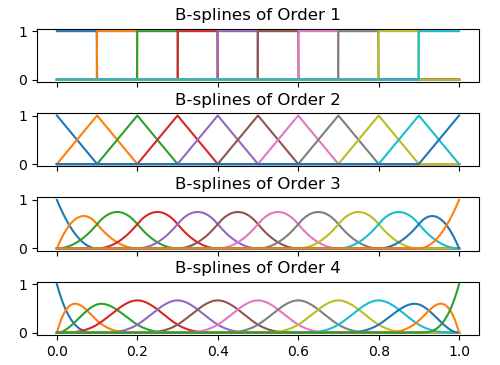
Implement in C++¶
C++ 中的科学计算库 GSL 也提供了 B 样条的实现方法。定义结点序列为
其中
- $t_0, \ldots, t_{k-1}$ 和 $t_{n}, \ldots, t_{n+k-1}$ 为增广序列
- $t_{k}, \ldots, t_{n-1}$ 为内结点序列,即 $K$ =
n-k= n - M - $t_{k-1}, t_{n}$ 为边界结点
这类似 Python 文档中的表述,但要注意这里 $k$ 是 order,而不是 degree。很直接的判断方法是看 B spline 的递推式,在 Python 中,递推式从 $B_{i,0}(x)$ 到 $B_{i,k}(x)$,而 GSL 的文档中从 $B_{i,1}(x)$ 到 $B_{i,k}(x)$,这与 ESL 中一致,所以从第二个脚标,可以发现 python 中 k 代表 degree,而 GSL 中代表 order.
拟合 B spline 的函数为
# init
gsl_bspline_workspace * gsl_bspline_alloc(const size_t k, const size_t nbreak)
# construct knots
int gsl_bspline_knots(const gsl_vector * breakpts, gsl_bspline_workspace * w)
int gsl_bspline_knots_uniform(const double a, const double b, gsl_bspline_workspace * w)
# evaluation
int gsl_bspline_eval(const double x, gsl_vector * B, gsl_bspline_workspace * w)
int gsl_bspline_eval_nonzero(const double x, gsl_vector * Bk, size_t * istart, size_t * iend, gsl_bspline_workspace * w)
# free
gsl_bspline_free(gsl_bspline_workspace * w)
实现代码为,
#include <iostream>
#include <cstdlib>
#include <gsl/gsl_bspline.h>
using namespace std;
int main(int argc, char *argv[])
{
size_t order = atoi(argv[1]);
size_t nbreaks = 11;
// number of data points
size_t n = 1000;
size_t ncoeffs = nbreaks + order - 2;
gsl_bspline_workspace *bw;
gsl_matrix *X;
gsl_vector *B;
size_t i, j;
// alloc a order-k bspline workspace
bw = gsl_bspline_alloc(order, nbreaks);
X = gsl_matrix_alloc(n, ncoeffs);
B = gsl_vector_alloc(ncoeffs);
// use uniform breakpoints
gsl_bspline_knots_uniform(0.0, 1.0, bw);
for (i = 0; i < n; i++)
{
double xi = 1.0 * (i + 1) / n;
// compute B_j(x_i) for all j
gsl_bspline_eval(xi, B, bw);
// fill in row i of X
for (j = 0; j < ncoeffs; j++)
{
double Bj = gsl_vector_get(B, j);
if (j != ncoeffs - 1)
cout << Bj << "\t";
else
cout << Bj << endl;
gsl_matrix_set(X, i, j, Bj);
}
}
gsl_vector_free(B);
gsl_matrix_free(X);
gsl_bspline_free(bw);
return 0;
}
画图一开始试了下 gnuplot,但是不是很熟悉,只是简单地得到了下图,
gnuplot -e "set term png; set output 'bsplines4.png'; set title 'B-splines of Order 4'; plot for [col=1:13] 'res.txt' using 0:col with lines notitle"
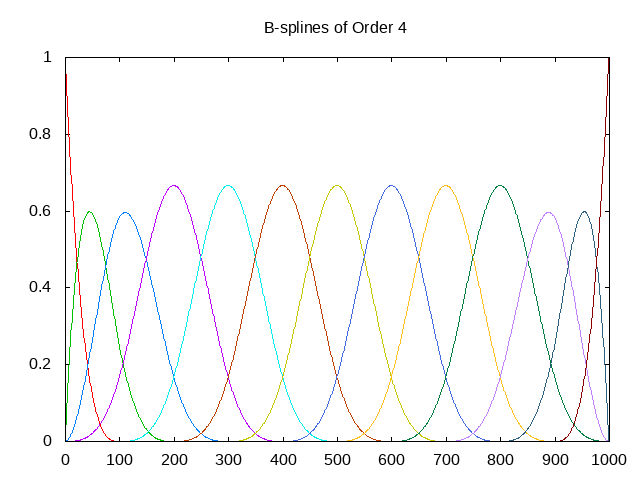
后来还是采用 R 来调用 C++ 程序,进而画图,
bspline <- function (order = 4, tmpfile = tempfile(), exec = file.path(".", "bspline")){
command = paste(exec, order, ">", tmpfile)
system(command)
read.table(tmpfile)
}
par(mfrow = c(4, 1), mar=c(2.1, 4.1, 2.1, 2.1))
for (order in 1:4) {
data = bspline(order)
matplot(1:1000*0.001, data, xlab = "", ylab = "", type = "l", lwd = 2)
title(paste("B-splies of Order", order))
}
